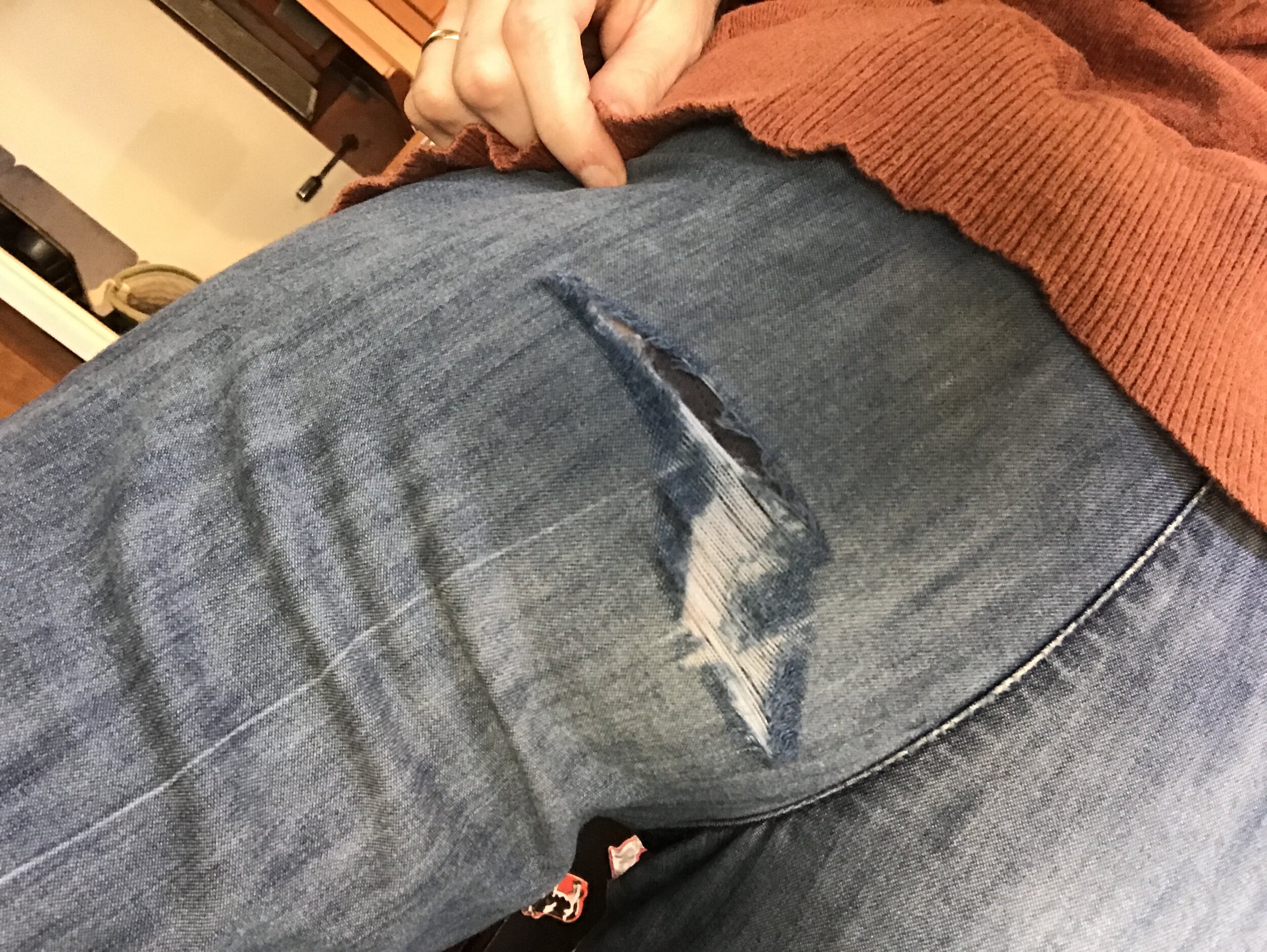Wabi-sabi Bodies
“It’s difficult to summarize wabi-sabi, but, in short, it’s about embracing the beauty of imperfection, the natural process of aging and decay, and the opportunity to view maturation as a natural and inevitable progression that imparts depth, wisdom, character, and earned beauty that could not otherwise be attained.”
I stumbled upon this passage while reading Mending Matters. The author is referring to the Japanese idea of wabi-sabi in the context of mending worn fabrics and avoiding the trap of perfectionism in doing so. I was supposed to have my mind on clothes but these words made me think about bodies.
Is this a perfectly “balanced” body?
Although the word “decay” can make a living body shudder, I found many parallels between the earned beauty in a pair of well-worn jeans and a life well-lived.
When I think about the wabi-sabi parts of my own body, I think of the sparkles growing in my hair and the wrinkles on my well-stretched belly. It’s fairly easy for me to welcome these physical changes and to appreciate them as beauty well-earned. There is some periodic struggle with the appearance of my belly, but I go through phases with it.
Then there’s the aches and pains. I have some arthritis in one knuckle in my left hand. Over the summer I had some disc issues and lower back pain (mostly resolved, thankfully). And one morning about a month ago, I woke up with a painful crick in my neck. The pain is gone but my movement is still restricted in some ways. It’s harder for me to acknowledge the “earned beauty” in these ailments.
Just like our clothing wears in predictable places based on the ways we move over time, our bodies can wear. Parts of us that felt fine in the past start to creak or ache and sometimes we wear through our joints and need to get new ones.
I think one of the reasons it’s so much harder to honor these worn places in my body is because they sometimes cause me pain. Based on what I know about pain science and the subjective nature of pain, however, I’m sure that adopting a “wabi-sabi” sense of honoring the story behind the wear and tear would shift my relationship with the pain I feel. This would require a heavy dose of self-compassion, gratitude, and lovingkindness toward all my achy parts.
Instead of feeling nagged by the arthritic joint in my ring finger, it would take some doing to reframe my thinking—to remember the story of my hands. If my ring finger could talk, it might tell me about all the work it’s done to help other people feel better. It might tell me about all the gripping and carrying it’s done. When I remember the big picture, the whole story, it creates a sense of softening and acceptance toward that achy spot.
These jeans originally belonged to the famed Jen Beyt Coffin.
When a pair of jeans gets a hole in the knee (or the seat, as was the case with me last week), we can either throw them away, reuse them in a new way, or mend them back to functionality. If we opt to mend the jeans, we can choose an exterior visible patch or an interior “invisible” patch.
We can do this with our bodies too, although it looks a little different. When a part wears out, we may use pain killers or other holistic means like massage, movement therapy, or acupuncture as an invisible or interior patch to help us manage pain or discomfort. Perhaps we stabilize the worn area with an exterior patch like a brace. We may recruit other parts of our bodies to do the work of the worn spot, thus adapting our movement patterns or even altering our activities. We may choose to discard the worn spot (especially if it is a joint) and replace it with a new one.
Our bodies begin life on Earth already somewhat imperfect—we’re not symmetrical. For a long time, I practiced yoga to help me find these asymmetries and figure out how to correct them. Eventually, I cam to realize that we can’t expect our exteriors to look perfectly symmetrical when our interiors aren’t. The heart is off center; the lungs are different sizes; the abdominal organs differ from left to right. With that in mind, the quest for a perfectly “balanced” body seems futile and quite possibly unimportant.* On the other hand, my physical practice has served as a vehicle for self inquiry and I have gained a lot of information about how to get more of my parts moving.
Sometimes we cover up the signs of aging or wear and tear on our bodies for cosmetic reasons as opposed to functional reasons. Cosmetic surgery falls at one end of the spectrum, with anti-aging skincare products maybe falling somewhere towards the other end. Perhaps these aren’t quests for perfection but maybe just “bolsters” to make things easier physically or emotionally. In a physical practice like yoga or restorative exercise, a bolster doesn’t necessarily indicate a handicap or a restriction. Instead, it can set our bodies and ourselves in a position to enjoy greater movement toward a chosen alignment, physical form, or value. It’s still mending and it’s still part of the story.
All this talk of mending naturally makes me think of tending (because I like rhymes). In order to embrace these wabi-sabi, beautifully imperfect bodies we have, we need to tend to ourselves with self-compassion—we need to act with tenderness toward our worn places. This often requires a bolster of some sort (or a patch for reinforcement) and definitely requires some kind of acceptance of the imperfection.
I hope to find harmony in working towards a life of less pain, more movement, and more freedom, while also respecting the parts of me that are showing wear and tear. I’m hoping to keep the mindset that my worn places are not necessarily signs of decay, but rather signs of a life lived, or a record of a set number of years moving or not moving in one way or another—not necessarily good or bad, just a body telling its story in its own language.
If your body could talk, what would it say?
“Ultimately, we come to accept our imperfect selves by embracing our own physical aging and the experiences and wisdom our bodies have accumulated over time.”
*What does it mean to have a “balanced” body? Is it a body in which all the muscles are equally strong? Does it refer to symmetry? Would it be true to say that only the folks in the world who have “balanced” bodies move and live 100% pain free? In the words of Dwight Schrute, “False.”



